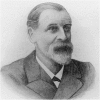Abstract
One of the most important advances in the treatment of musculoskeletal injuries has come from understanding that controlled early resumption of activity can promote restoration of function, and that treatment of injuries with prolonged rest may delay recovery and adversely affect normal tissues. In the last decade of the nineteenth century two widely respected orthopaedists with extensive clinical experience strongly advocated opposing treatments of musculoskeletal injuries. Hugh Owen Thomas in Liverpool believed that enforced, uninterrupted prolonged rest produced the best results. He noted that movement of injured tissues increased inflammation, and that, "It would indeed be as reasonable to attempt to cure a fever patient by kicking him out of bed, as to benefit joint disease by a wriggling at the articulation." Just Lucas-Championnier in Paris took the opposite position. He argued that early controlled active motion accelerated restoration of function, although he noted that mobility had to be given in limited doses. In general, Thomas' views met with greater acceptance in the early part of this century, but experimental studies of the last several decades generally support Lucas-Championneir. They confirm and help explain the deleterious effects of prolonged rest and the beneficial effects of activity on the musculoskeletal tissues. They have shown that maintenance of normal bone, tendon and ligament, articular cartilage and muscle structure and composition require repetitive use, and that changes in the patterns of tissue loading can strengthen or weaken normal tissues. Although all the musculoskeletal tissues can respond to repetitive loading, they vary in the magnitude and type of response to specific patterns of activity. Furthermore, their responsiveness may decline with increasing age. Skeletal muscle and bone demonstrate the most apparent response to changes in activity in individuals of any age. Cartilage and dense fibrous tissues also can respond to loading, but the responses are more difficult to measure. The effects of loading on injured tissues have been less extensively studied, but the available evidence indicates that repair tissues respond to loading and, like immature normal tissues, may be more sensitive to cyclic loading and motion than mature normal tissues. However, early motion and loading of injured tissues is not without risks. Premature or excessive loading and motion of repair tissue can inhibit or stop repair. Unfortunately, the optimal methods of facilitating healing by early application of loading and motion have not been defined.(ABSTRACT TRUNCATED AT 400 WORDS)
Full text
PDF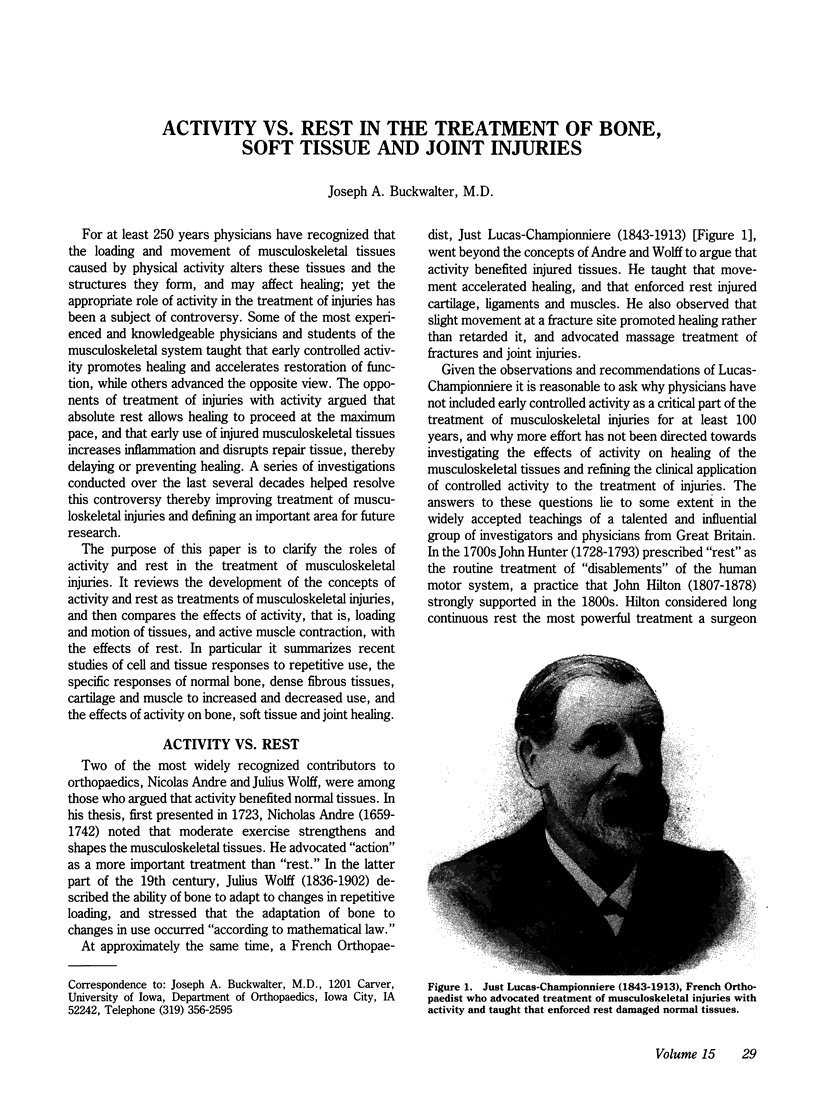
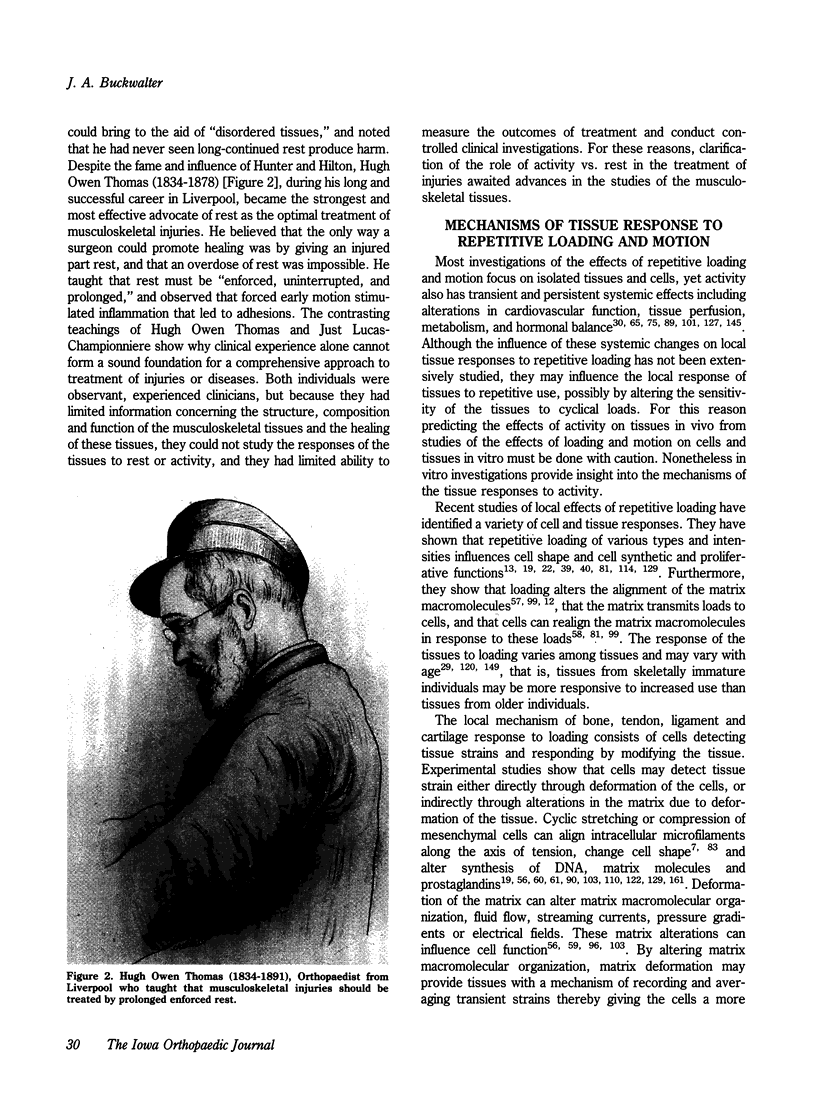
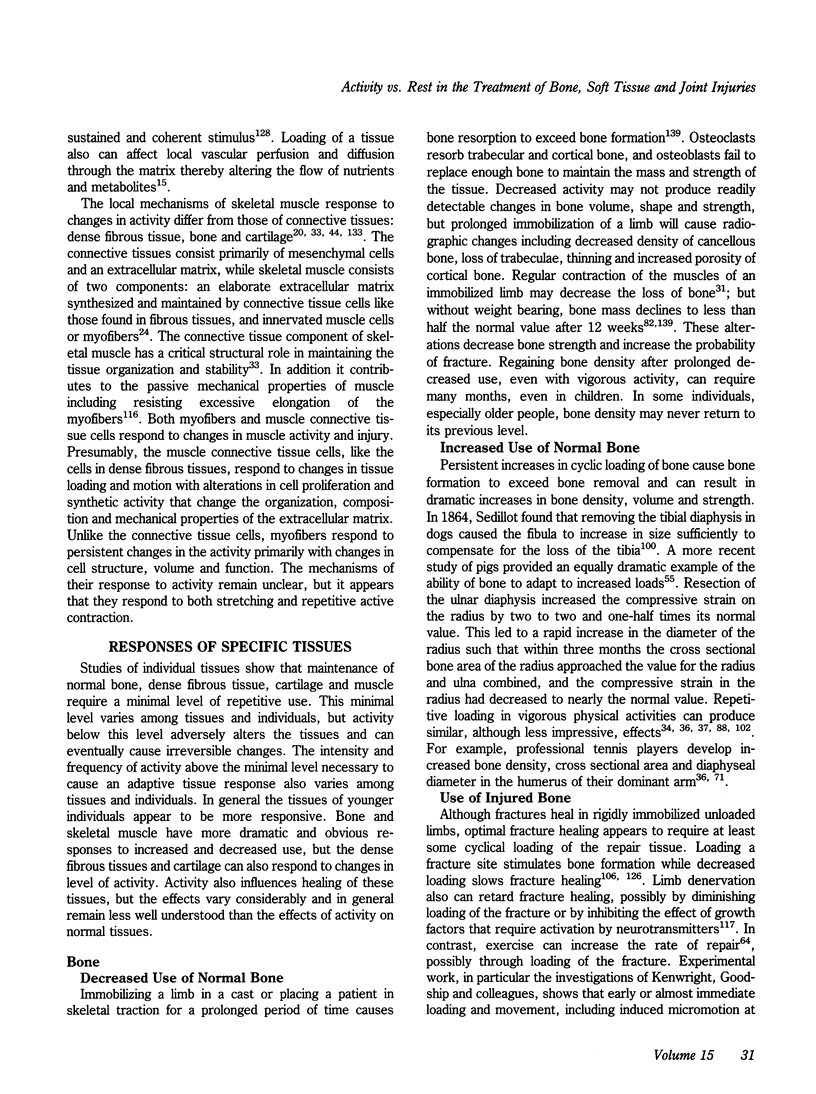
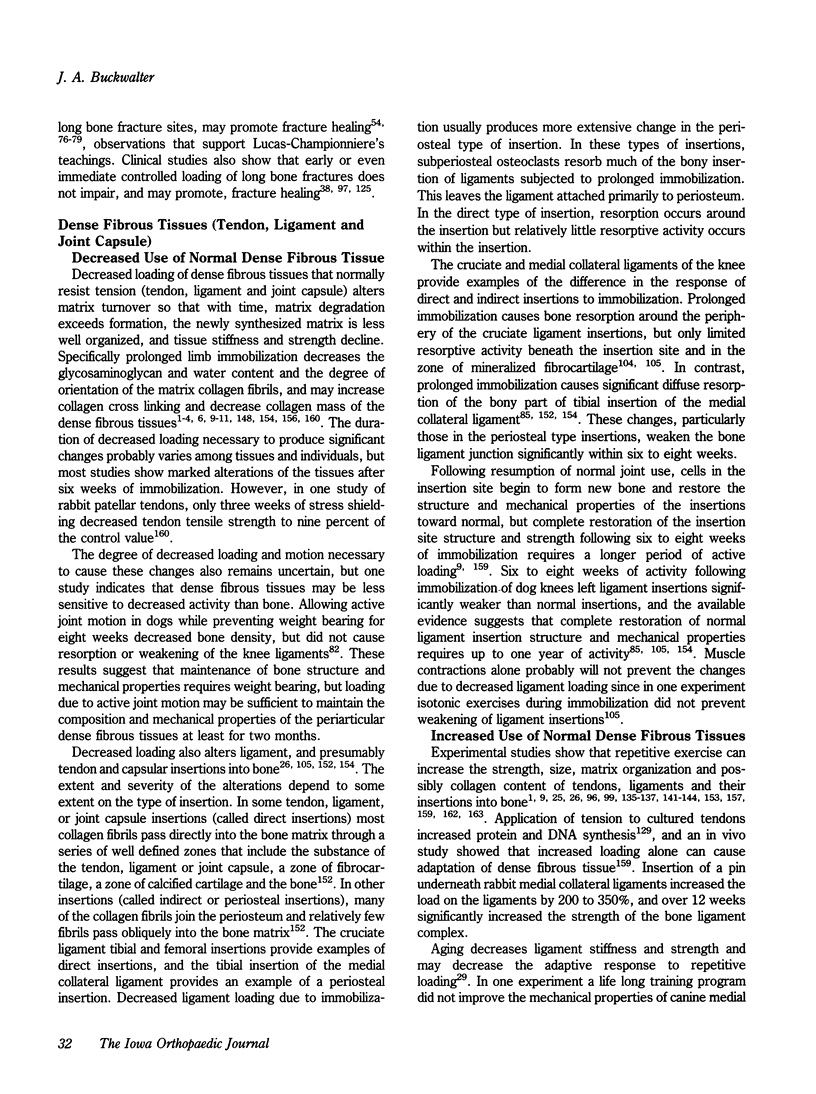
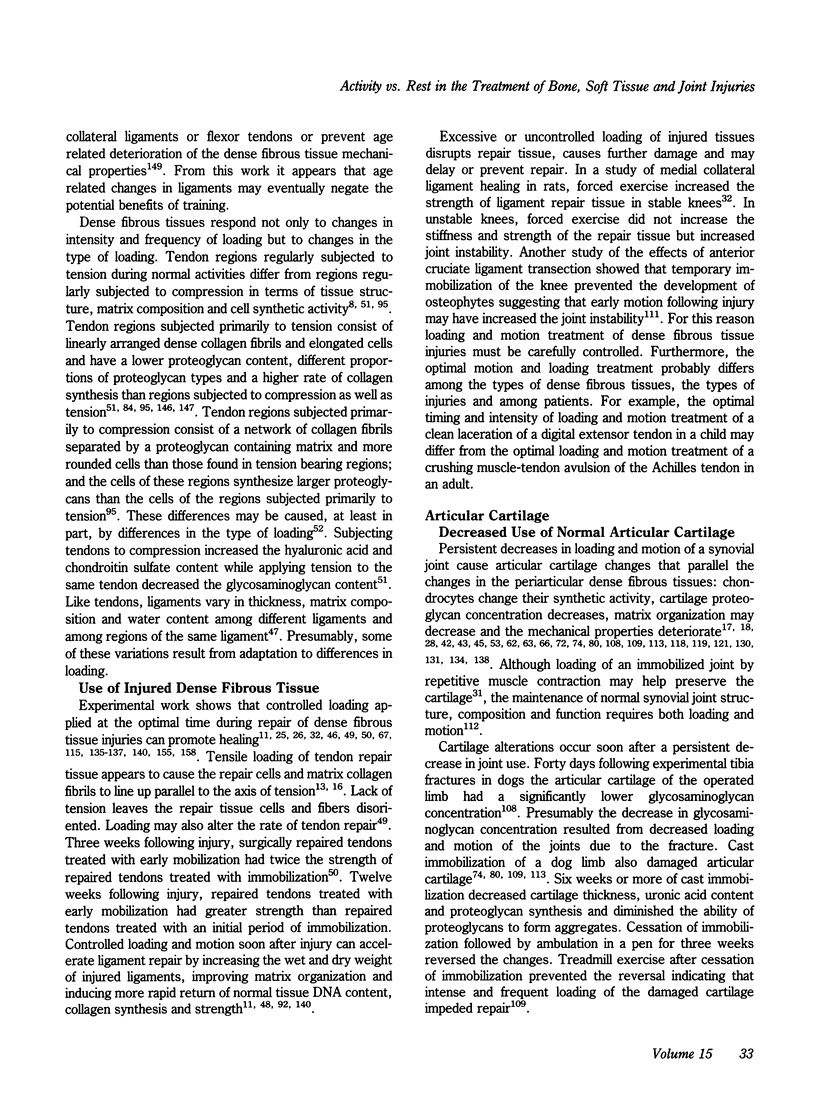
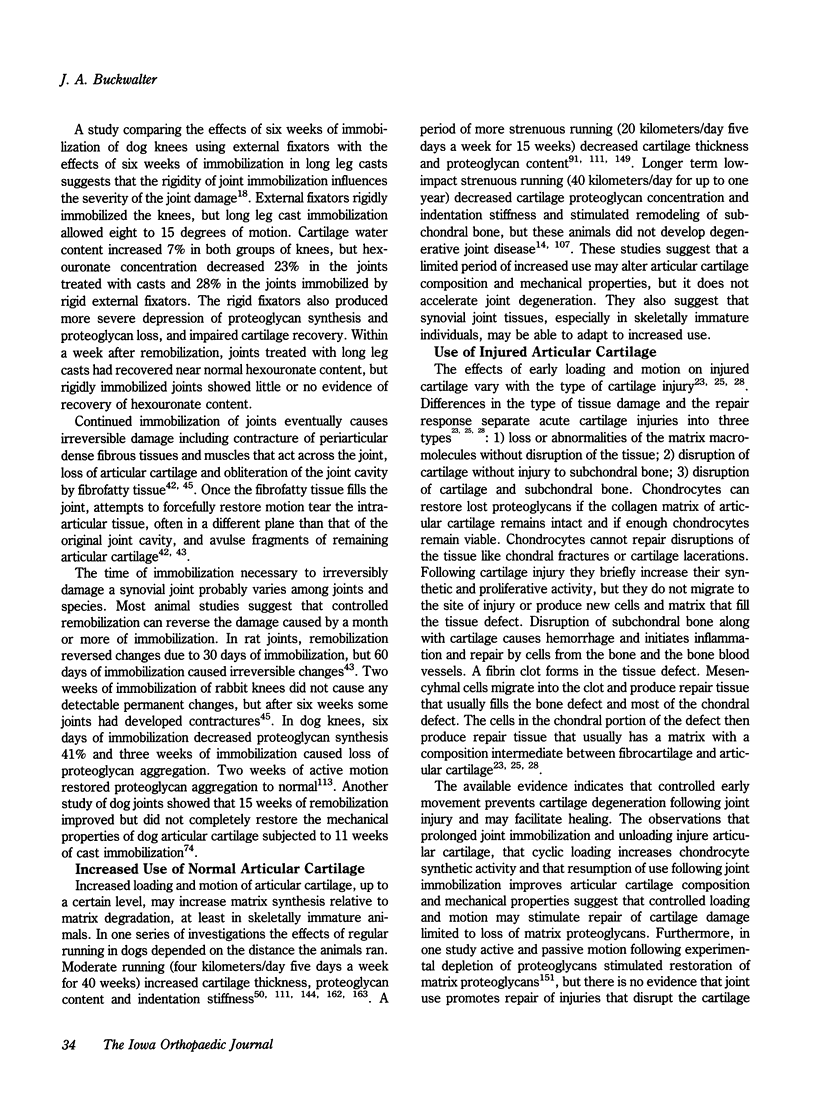
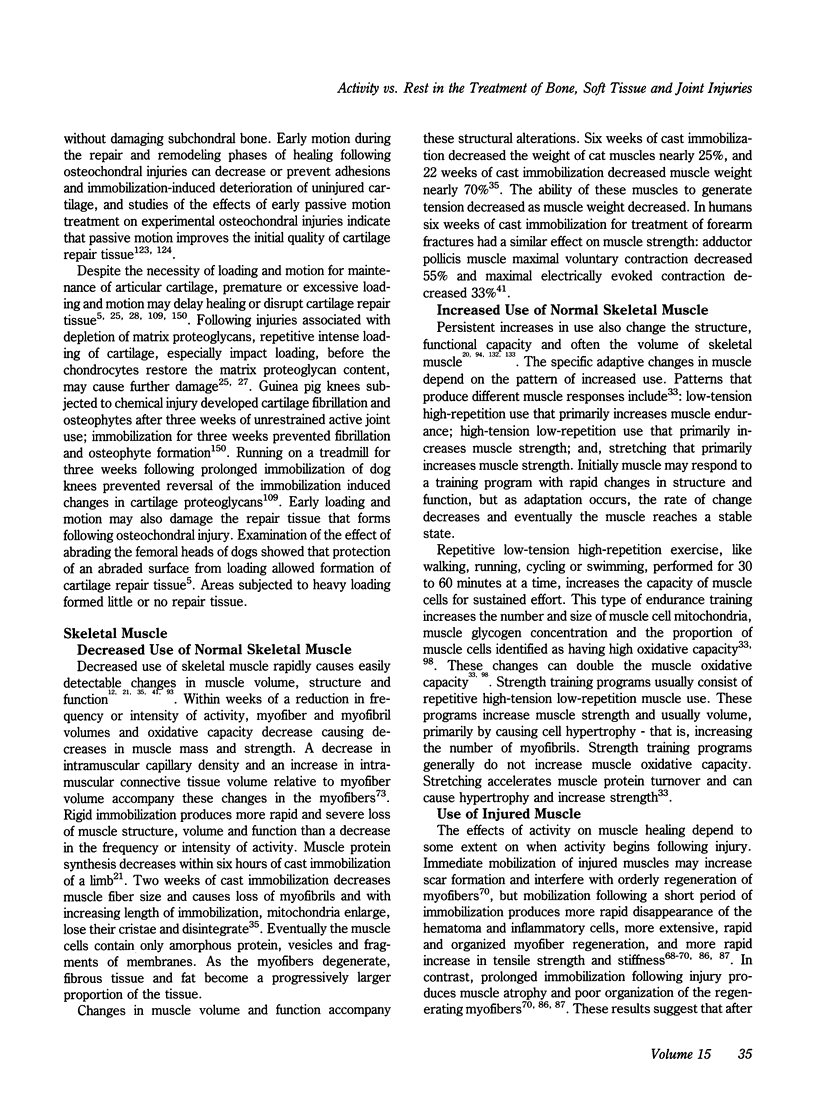

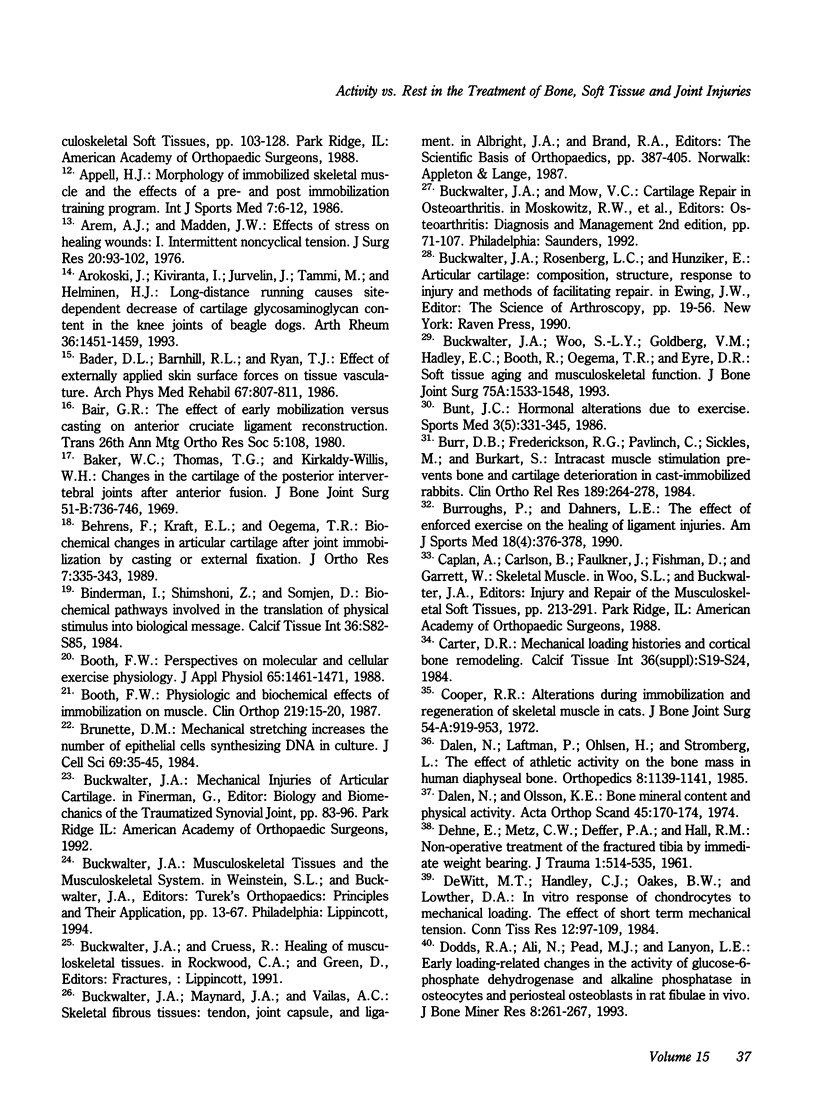
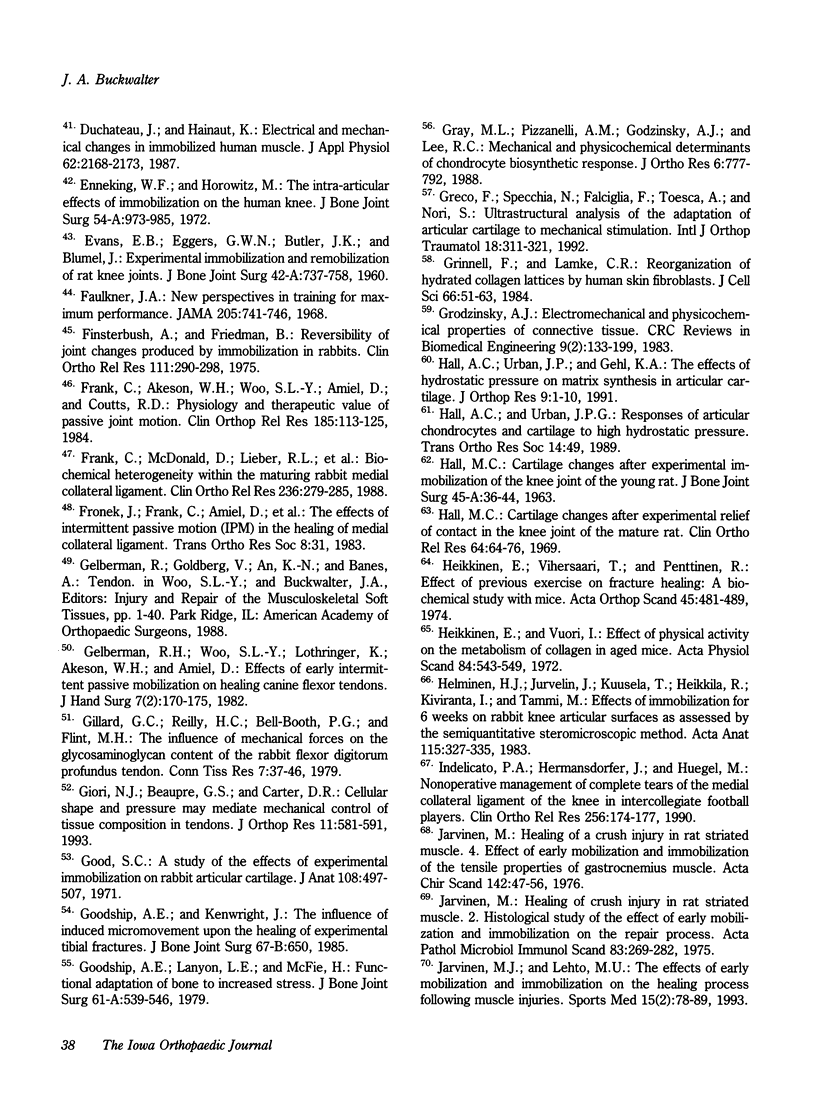
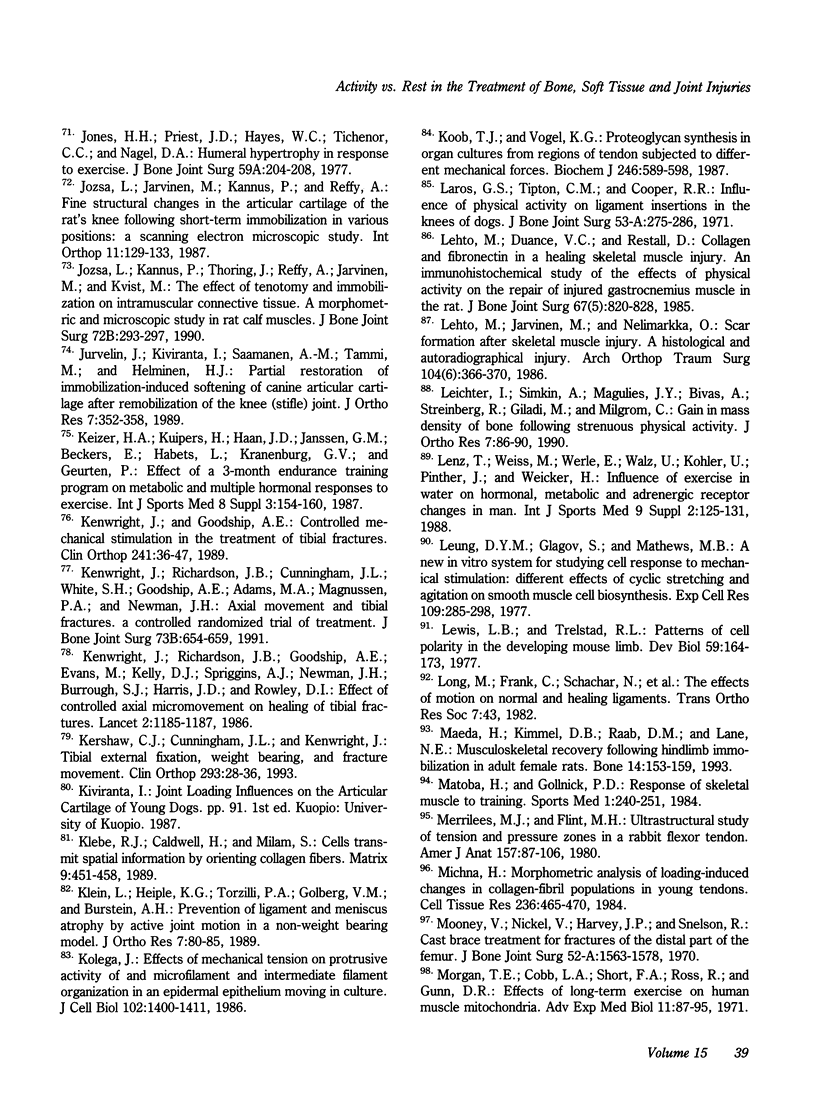
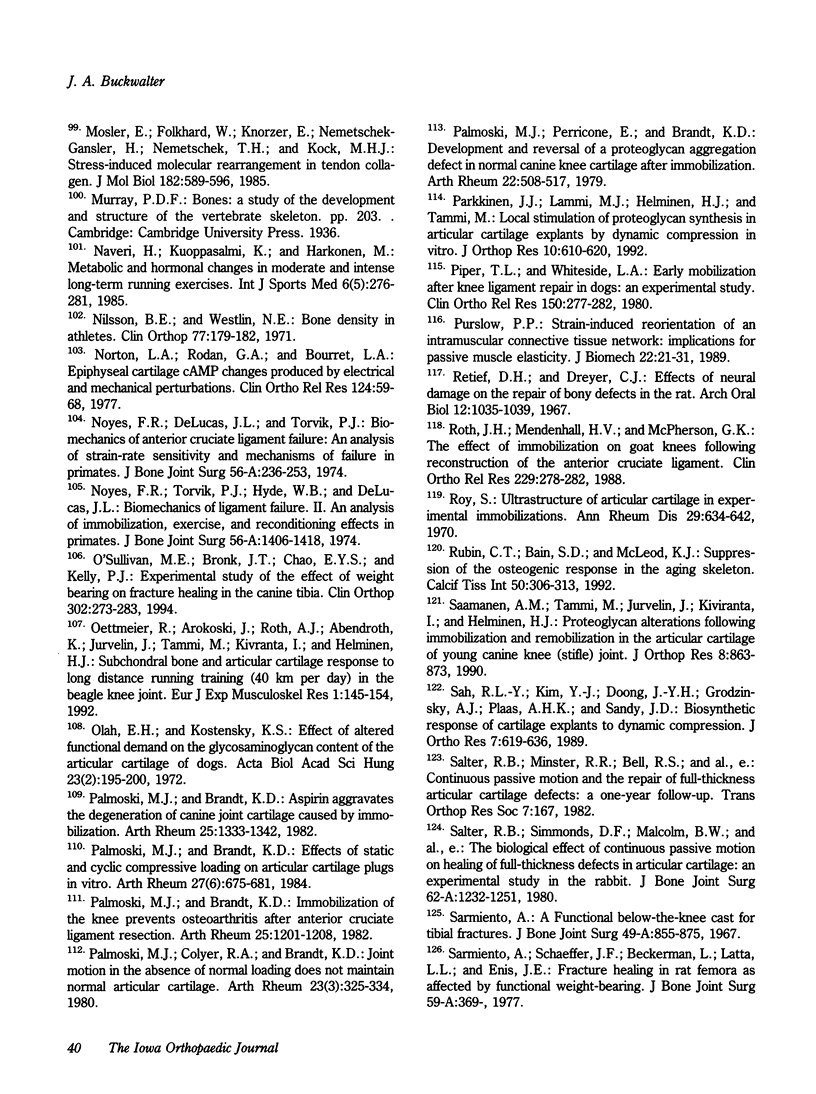
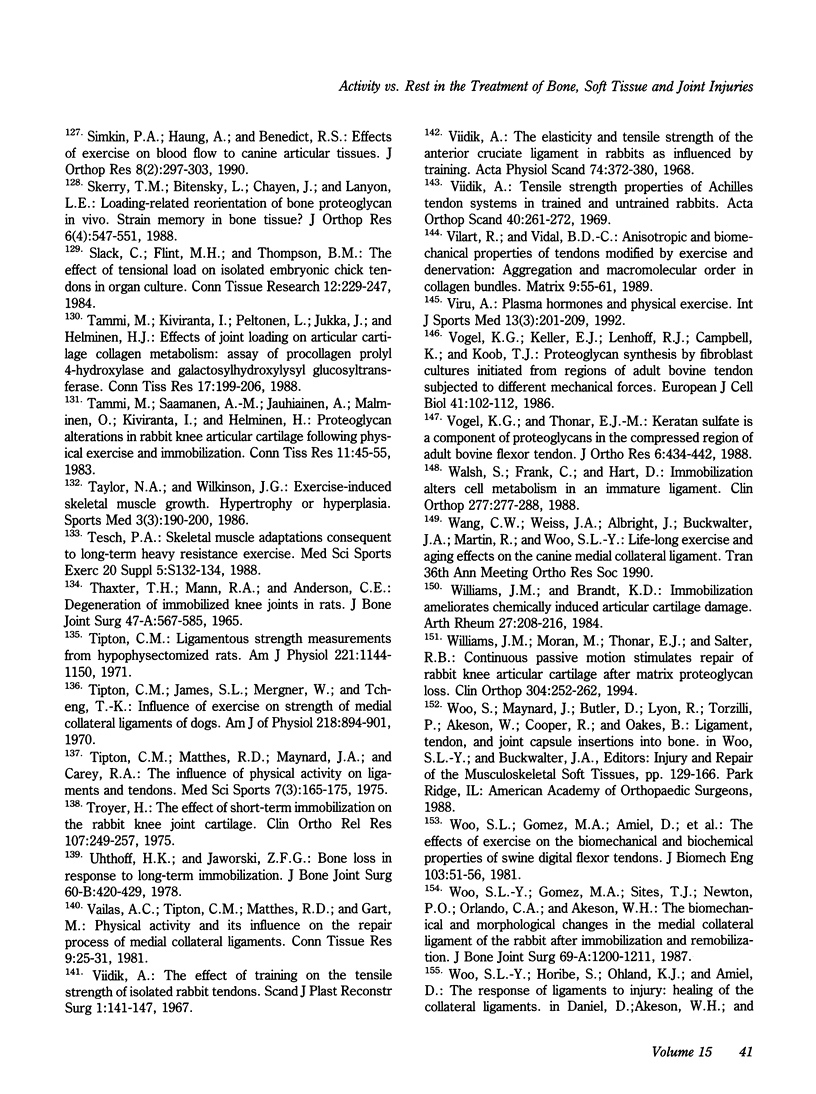
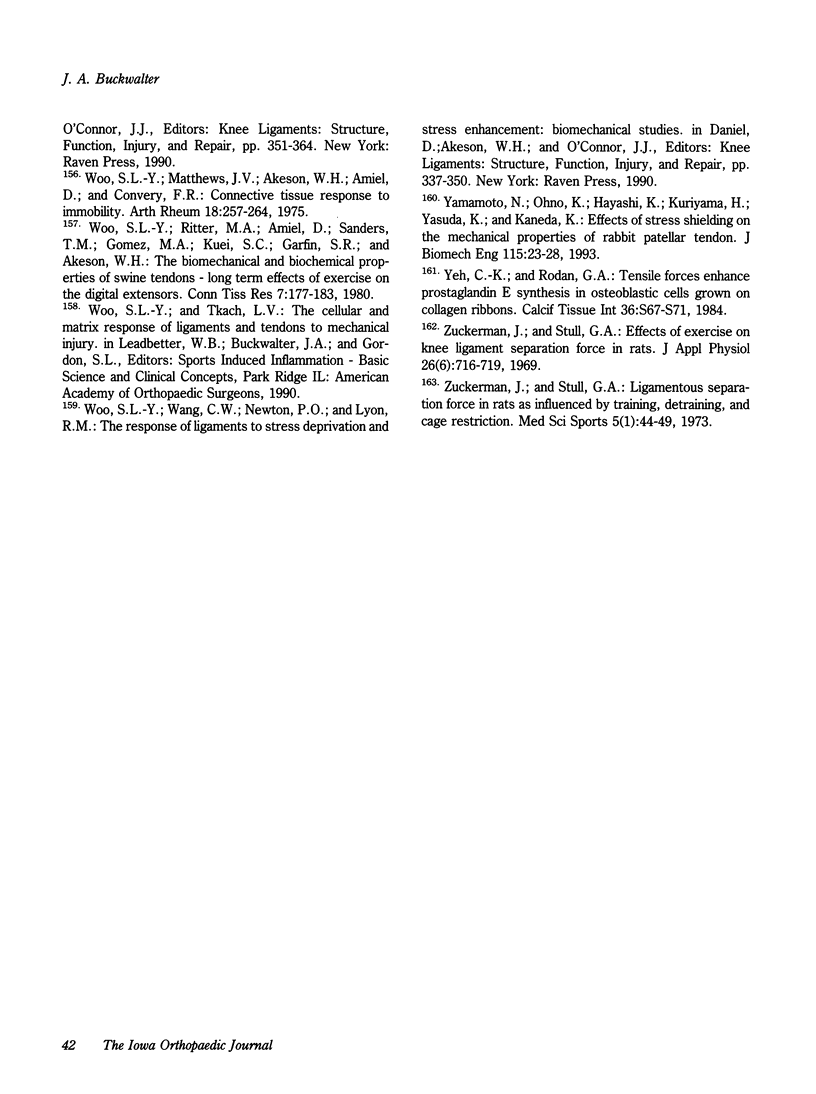
Images in this article
Selected References
These references are in PubMed. This may not be the complete list of references from this article.
- Akeson W. H., Amiel D., LaViolette D. The connective-tissue response to immobility: a study of the chondroitin-4 and 6-sulfate and dermatan sulfate changes in periarticular connective tissue of control and immobilized knees of dogs. Clin Orthop Relat Res. 1967 Mar-Apr;51:183–197. [PubMed] [Google Scholar]
- Akeson W. H., Amiel D., Mechanic G. L., Woo S. L., Harwood F. L., Hamer M. L. Collagen cross-linking alterations in joint contractures: changes in the reducible cross-links in periarticular connective tissue collagen after nine weeks of immobilization. Connect Tissue Res. 1977;5(1):15–19. doi: 10.3109/03008207709152607. [DOI] [PubMed] [Google Scholar]
- Akeson W. H., Amiel D., Woo S. L. Immobility effects on synovial joints the pathomechanics of joint contracture. Biorheology. 1980;17(1-2):95–110. doi: 10.3233/bir-1980-171-212. [DOI] [PubMed] [Google Scholar]
- Akeson W. H., Miyashita C., Taylor T. K., Laviolette D., Amiel D. Experimental arthroplasty of the canine hip. Extracellular matrix composition in cup arthroplasty. J Bone Joint Surg Am. 1969 Jan;51(1):149–164. [PubMed] [Google Scholar]
- Albrecht-Buehler G. Role of cortical tension in fibroblast shape and movement. Cell Motil Cytoskeleton. 1987;7(1):54–67. doi: 10.1002/cm.970070108. [DOI] [PubMed] [Google Scholar]
- Amiel D., Woo S. L., Harwood F. L., Akeson W. H. The effect of immobilization on collagen turnover in connective tissue: a biochemical-biomechanical correlation. Acta Orthop Scand. 1982 Jun;53(3):325–332. doi: 10.3109/17453678208992224. [DOI] [PubMed] [Google Scholar]
- Appell H. J. Morphology of immobilized skeletal muscle and the effects of a pre- and postimmobilization training program. Int J Sports Med. 1986 Feb;7(1):6–12. doi: 10.1055/s-2008-1025726. [DOI] [PubMed] [Google Scholar]
- Arem A. J., Madden J. W. Effects of stress on healing wounds: I. Intermittent noncyclical tension. J Surg Res. 1976 Feb;20(2):93–102. doi: 10.1016/0022-4804(76)90104-9. [DOI] [PubMed] [Google Scholar]
- Arokoski J., Kiviranta I., Jurvelin J., Tammi M., Helminen H. J. Long-distance running causes site-dependent decrease of cartilage glycosaminoglycan content in the knee joints of beagle dogs. Arthritis Rheum. 1993 Oct;36(10):1451–1459. doi: 10.1002/art.1780361018. [DOI] [PubMed] [Google Scholar]
- Bader D. L., Barnhill R. L., Ryan T. J. Effect of externally applied skin surface forces on tissue vasculature. Arch Phys Med Rehabil. 1986 Nov;67(11):807–811. [PubMed] [Google Scholar]
- Baker W. de C., Thomas T. G., Kirkaldy-Willis W. H. Changes in the cartilage of the posterior intervertebral joints after anterior fusion. J Bone Joint Surg Br. 1969 Nov;51(4):736–746. [PubMed] [Google Scholar]
- Behrens F., Kraft E. L., Oegema T. R., Jr Biochemical changes in articular cartilage after joint immobilization by casting or external fixation. J Orthop Res. 1989;7(3):335–343. doi: 10.1002/jor.1100070305. [DOI] [PubMed] [Google Scholar]
- Binderman I., Shimshoni Z., Somjen D. Biochemical pathways involved in the translation of physical stimulus into biological message. Calcif Tissue Int. 1984;36 (Suppl 1):S82–S85. doi: 10.1007/BF02406139. [DOI] [PubMed] [Google Scholar]
- Booth F. W. Perspectives on molecular and cellular exercise physiology. J Appl Physiol (1985) 1988 Oct;65(4):1461–1471. doi: 10.1152/jappl.1988.65.4.1461. [DOI] [PubMed] [Google Scholar]
- Brunette D. M. Mechanical stretching increases the number of epithelial cells synthesizing DNA in culture. J Cell Sci. 1984 Jul;69:35–45. doi: 10.1242/jcs.69.1.35. [DOI] [PubMed] [Google Scholar]
- Bunt J. C. Hormonal alterations due to exercise. Sports Med. 1986 Sep-Oct;3(5):331–345. doi: 10.2165/00007256-198603050-00003. [DOI] [PubMed] [Google Scholar]
- Burroughs P., Dahners L. E. The effect of enforced exercise on the healing of ligament injuries. Am J Sports Med. 1990 Jul-Aug;18(4):376–378. doi: 10.1177/036354659001800407. [DOI] [PubMed] [Google Scholar]
- Carter D. R. Mechanical loading histories and cortical bone remodeling. Calcif Tissue Int. 1984;36 (Suppl 1):S19–S24. doi: 10.1007/BF02406129. [DOI] [PubMed] [Google Scholar]
- Cooper R. R. Alterations during immobilization and regeneration of skeletal muscle in cats. J Bone Joint Surg Am. 1972 Jul;54(5):919–953. [PubMed] [Google Scholar]
- DEHNE E., METZ C. W., DEFFER P. A., HALL R. M. Nonoperative treatment of the fractured tibia by immediate weight bearing. J Trauma. 1961 Sep;1:514–535. [PubMed] [Google Scholar]
- Dalén N., Låftman P., Ohlsén H., Strömberg L. The effect of athletic activity on the bone mass in human diaphyseal bone. Orthopedics. 1985 Sep;8(9):1139–1141. doi: 10.3928/0147-7447-19850901-11. [DOI] [PubMed] [Google Scholar]
- Dalén N., Olsson K. E. Bone mineral content and physical activity. Acta Orthop Scand. 1974;45(2):170–174. doi: 10.3109/17453677408989136. [DOI] [PubMed] [Google Scholar]
- De Witt M. T., Handley C. J., Oakes B. W., Lowther D. A. In vitro response of chondrocytes to mechanical loading. The effect of short term mechanical tension. Connect Tissue Res. 1984;12(2):97–109. doi: 10.3109/03008208408992775. [DOI] [PubMed] [Google Scholar]
- Dodds R. A., Ali N., Pead M. J., Lanyon L. E. Early loading-related changes in the activity of glucose 6-phosphate dehydrogenase and alkaline phosphatase in osteocytes and periosteal osteoblasts in rat fibulae in vivo. J Bone Miner Res. 1993 Mar;8(3):261–267. doi: 10.1002/jbmr.5650080303. [DOI] [PubMed] [Google Scholar]
- Duchateau J., Hainaut K. Electrical and mechanical changes in immobilized human muscle. J Appl Physiol (1985) 1987 Jun;62(6):2168–2173. doi: 10.1152/jappl.1987.62.6.2168. [DOI] [PubMed] [Google Scholar]
- Enneking W. F., Horowitz M. The intra-articular effects of immobilization on the human knee. J Bone Joint Surg Am. 1972 Jul;54(5):973–985. [PubMed] [Google Scholar]
- Faulkner J. A. New perspectives in training for maximum performance. JAMA. 1968 Sep 9;205(11):741–746. [PubMed] [Google Scholar]
- Frank C., McDonald D., Lieber R., Sabiston P. Biochemical heterogeneity within the maturing rabbit medial collateral ligament. Clin Orthop Relat Res. 1988 Nov;(236):279–285. [PubMed] [Google Scholar]
- Gelberman R. H., Woo S. L., Lothringer K., Akeson W. H., Amiel D. Effects of early intermittent passive mobilization on healing canine flexor tendons. J Hand Surg Am. 1982 Mar;7(2):170–175. doi: 10.1016/s0363-5023(82)80083-x. [DOI] [PubMed] [Google Scholar]
- Gillard G. C., Reilly H. C., Bell-Booth P. G., Flint M. H. The influence of mechanical forces on the glycosaminoglycan content of the rabbit flexor digitorum profundus tendon. Connect Tissue Res. 1979;7(1):37–46. doi: 10.3109/03008207909152351. [DOI] [PubMed] [Google Scholar]
- Giori N. J., Beaupré G. S., Carter D. R. Cellular shape and pressure may mediate mechanical control of tissue composition in tendons. J Orthop Res. 1993 Jul;11(4):581–591. doi: 10.1002/jor.1100110413. [DOI] [PubMed] [Google Scholar]
- Goodship A. E., Kenwright J. The influence of induced micromovement upon the healing of experimental tibial fractures. J Bone Joint Surg Br. 1985 Aug;67(4):650–655. doi: 10.1302/0301-620X.67B4.4030869. [DOI] [PubMed] [Google Scholar]
- Goodship A. E., Lanyon L. E., McFie H. Functional adaptation of bone to increased stress. An experimental study. J Bone Joint Surg Am. 1979 Jun;61(4):539–546. [PubMed] [Google Scholar]
- Gray M. L., Pizzanelli A. M., Grodzinsky A. J., Lee R. C. Mechanical and physiochemical determinants of the chondrocyte biosynthetic response. J Orthop Res. 1988;6(6):777–792. doi: 10.1002/jor.1100060602. [DOI] [PubMed] [Google Scholar]
- Greco F., Specchia N., Falciglia F., Toesca A., Nori S. Ultrastructural analysis of the adaptation of articular cartilage to mechanical stimulation. Ital J Orthop Traumatol. 1992;18(3):311–321. [PubMed] [Google Scholar]
- Grinnell F., Lamke C. R. Reorganization of hydrated collagen lattices by human skin fibroblasts. J Cell Sci. 1984 Mar;66:51–63. doi: 10.1242/jcs.66.1.51. [DOI] [PubMed] [Google Scholar]
- Grodzinsky A. J. Electromechanical and physicochemical properties of connective tissue. Crit Rev Biomed Eng. 1983;9(2):133–199. [PubMed] [Google Scholar]
- Hall A. C., Urban J. P., Gehl K. A. The effects of hydrostatic pressure on matrix synthesis in articular cartilage. J Orthop Res. 1991 Jan;9(1):1–10. doi: 10.1002/jor.1100090102. [DOI] [PubMed] [Google Scholar]
- Heikkinen E., Vihersaari T., Penttinen R. Effect of previous exercise on fracture healing: a biochemical study with mice. Acta Orthop Scand. 1974;45(4):481–489. doi: 10.3109/17453677408989171. [DOI] [PubMed] [Google Scholar]
- Heikkinen E., Vuori I. Effect of physical activity on the metabolism of collagen in aged mice. Acta Physiol Scand. 1972 Apr;84(4):543–549. doi: 10.1111/j.1748-1716.1972.tb05206.x. [DOI] [PubMed] [Google Scholar]
- Helminen H. J., Jurvelin J., Kuusela T., Heikkilä R., Kiviranta I., Tammi M. Effects of immobilization for 6 weeks on rabbit knee articular surfaces as assessed by the semiquantitative stereomicroscopic method. Acta Anat (Basel) 1983 Apr;115(4):327–335. doi: 10.1159/000145709. [DOI] [PubMed] [Google Scholar]
- Holmes L. B., Trelstad R. L. Patterns of cell polarity in the developing mouse limb. Dev Biol. 1977 Sep;59(2):164–173. doi: 10.1016/0012-1606(77)90251-2. [DOI] [PubMed] [Google Scholar]
- Indelicato P. A., Hermansdorfer J., Huegel M. Nonoperative management of complete tears of the medial collateral ligament of the knee in intercollegiate football players. Clin Orthop Relat Res. 1990 Jul;(256):174–177. [PubMed] [Google Scholar]
- Jurvelin J., Kiviranta I., Sämänen A. M., Tammi M., Helminen H. J. Partial restoration of immobilization-induced softening of canine articular cartilage after remobilization of the knee (stifle) joint. J Orthop Res. 1989;7(3):352–358. doi: 10.1002/jor.1100070307. [DOI] [PubMed] [Google Scholar]
- Järvinen M. J., Lehto M. U. The effects of early mobilisation and immobilisation on the healing process following muscle injuries. Sports Med. 1993 Feb;15(2):78–89. doi: 10.2165/00007256-199315020-00002. [DOI] [PubMed] [Google Scholar]
- Järvinen M. Healing of a crush injury in rat striated muscle. 2. a histological study of the effect of early mobilization and immobilization on the repair processes. Acta Pathol Microbiol Scand A. 1975 May;83(3):269–282. [PubMed] [Google Scholar]
- Järvinen M. Healing of a crush injury in rat striated muscle. 4. Effect of early mobilization and immobilization on the tensile properties of gastrocnemius muscle. Acta Chir Scand. 1976;142(1):47–56. [PubMed] [Google Scholar]
- Józsa L., Järvinen M., Kannus P., Réffy A. Fine structural changes in the articular cartilage of the rat's knee following short-term immobilisation in various positions: a scanning electron microscopical study. Int Orthop. 1987;11(2):129–133. doi: 10.1007/BF00266698. [DOI] [PubMed] [Google Scholar]
- Keizer H. A., Kuipers H., de Haan J., Janssen G. M., Beckers E., Habets L., van Kranenburg G., Geurten P. Effect of a 3-month endurance training program on metabolic and multiple hormonal responses to exercise. Int J Sports Med. 1987 Dec;8 (Suppl 3):154–160. doi: 10.1055/s-2008-1025722. [DOI] [PubMed] [Google Scholar]
- Kenwright J., Richardson J. B., Goodship A. E., Evans M., Kelly D. J., Spriggins A. J., Newman J. H., Burrough S. J., Harris J. D., Rowley D. I. Effect of controlled axial micromovement on healing of tibial fractures. Lancet. 1986 Nov 22;2(8517):1185–1187. doi: 10.1016/s0140-6736(86)92196-3. [DOI] [PubMed] [Google Scholar]
- Klebe R. J., Caldwell H., Milam S. Cells transmit spatial information by orienting collagen fibers. Matrix. 1989;9(6):451–458. doi: 10.1016/s0934-8832(11)80014-4. [DOI] [PubMed] [Google Scholar]
- Klein L., Heiple K. G., Torzilli P. A., Goldberg V. M., Burstein A. H. Prevention of ligament and meniscus atrophy by active joint motion in a non-weight-bearing model. J Orthop Res. 1989;7(1):80–85. doi: 10.1002/jor.1100070111. [DOI] [PubMed] [Google Scholar]
- Kolega J. Effects of mechanical tension on protrusive activity and microfilament and intermediate filament organization in an epidermal epithelium moving in culture. J Cell Biol. 1986 Apr;102(4):1400–1411. doi: 10.1083/jcb.102.4.1400. [DOI] [PMC free article] [PubMed] [Google Scholar]
- Koob T. J., Vogel K. G. Proteoglycan synthesis in organ cultures from regions of bovine tendon subjected to different mechanical forces. Biochem J. 1987 Sep 15;246(3):589–598. doi: 10.1042/bj2460589. [DOI] [PMC free article] [PubMed] [Google Scholar]
- Laros G. S., Tipton C. M., Cooper R. R. Influence of physical activity on ligament insertions in the knees of dogs. J Bone Joint Surg Am. 1971 Mar;53(2):275–286. [PubMed] [Google Scholar]
- Lehto M., Duance V. C., Restall D. Collagen and fibronectin in a healing skeletal muscle injury. An immunohistological study of the effects of physical activity on the repair of injured gastrocnemius muscle in the rat. J Bone Joint Surg Br. 1985 Nov;67(5):820–828. doi: 10.1302/0301-620X.67B5.3902851. [DOI] [PubMed] [Google Scholar]
- Lehto M., Järvinen M., Nelimarkka O. Scar formation after skeletal muscle injury. A histological and autoradiographical study in rats. Arch Orthop Trauma Surg. 1986;104(6):366–370. doi: 10.1007/BF00454432. [DOI] [PubMed] [Google Scholar]
- Leichter I., Simkin A., Margulies J. Y., Bivas A., Steinberg R., Giladi M., Milgrom C. Gain in mass density of bone following strenuous physical activity. J Orthop Res. 1989;7(1):86–90. doi: 10.1002/jor.1100070112. [DOI] [PubMed] [Google Scholar]
- Leung D. Y., Glagov S., Mathews M. B. A new in vitro system for studying cell response to mechanical stimulation. Different effects of cyclic stretching and agitation on smooth muscle cell biosynthesis. Exp Cell Res. 1977 Oct 15;109(2):285–298. doi: 10.1016/0014-4827(77)90008-8. [DOI] [PubMed] [Google Scholar]
- Maeda H., Kimmel D. B., Raab D. M., Lane N. E. Musculoskeletal recovery following hindlimb immobilization in adult female rats. Bone. 1993 Mar-Apr;14(2):153–159. doi: 10.1016/8756-3282(93)90242-3. [DOI] [PubMed] [Google Scholar]
- Matoba H., Gollnick P. D. Response of skeletal muscle to training. Sports Med. 1984 May-Jun;1(3):240–251. doi: 10.2165/00007256-198401030-00006. [DOI] [PubMed] [Google Scholar]
- Merrilees M. J., Flint M. H. Ultrastructural study of tension and pressure zones in a rabbit flexor tendon. Am J Anat. 1980 Jan;157(1):87–106. doi: 10.1002/aja.1001570109. [DOI] [PubMed] [Google Scholar]
- Michna H. Morphometric analysis of loading-induced changes in collagen-fibril populations in young tendons. Cell Tissue Res. 1984;236(2):465–470. doi: 10.1007/BF00214251. [DOI] [PubMed] [Google Scholar]
- Mooney V., Nickel V. L., Harvey J. P., Jr, Snelson R. Cast-brace treatment for fractures of the distal part of the femur. A prospective controlled study of one hundred and fifty patients. J Bone Joint Surg Am. 1970 Dec;52(8):1563–1578. [PubMed] [Google Scholar]
- Mosler E., Folkhard W., Knörzer E., Nemetschek-Gansler H., Nemetschek T., Koch M. H. Stress-induced molecular rearrangement in tendon collagen. J Mol Biol. 1985 Apr 20;182(4):589–596. doi: 10.1016/0022-2836(85)90244-x. [DOI] [PubMed] [Google Scholar]
- Nilsson B. E., Westlin N. E. Bone density in athletes. Clin Orthop Relat Res. 1971;77:179–182. [PubMed] [Google Scholar]
- Norton L. A., Rodan G. A., Bourret L. A. Epiphyseal cartilage cAMP changes produced by electrical and mechanical perturbations. Clin Orthop Relat Res. 1977 May;(124):59–68. [PubMed] [Google Scholar]
- Noyes F. R., DeLucas J. L., Torvik P. J. Biomechanics of anterior cruciate ligament failure: an analysis of strain-rate sensitivity and mechanisms of failure in primates. J Bone Joint Surg Am. 1974 Mar;56(2):236–253. [PubMed] [Google Scholar]
- Noyes F. R., Torvik P. J., Hyde W. B., DeLucas J. L. Biomechanics of ligament failure. II. An analysis of immobilization, exercise, and reconditioning effects in primates. J Bone Joint Surg Am. 1974 Oct;56(7):1406–1418. [PubMed] [Google Scholar]
- Näveri H., Kuoppasalmi K., Härkönen M. Metabolic and hormonal changes in moderate and intense long-term running exercises. Int J Sports Med. 1985 Oct;6(5):276–281. doi: 10.1055/s-2008-1025851. [DOI] [PubMed] [Google Scholar]
- Oláh E. H., Kostenszky K. S. Effect of altered functional demand on the glycosaminoglycan content of the articular cartilage of dogs. Acta Biol Acad Sci Hung. 1972;23(2):195–200. [PubMed] [Google Scholar]
- Palmoski M. J., Brandt K. D. Aspirin aggravates the degeneration of canine joint cartilage caused by immobilization. Arthritis Rheum. 1982 Nov;25(11):1333–1342. doi: 10.1002/art.1780251109. [DOI] [PubMed] [Google Scholar]
- Palmoski M. J., Brandt K. D. Effects of static and cyclic compressive loading on articular cartilage plugs in vitro. Arthritis Rheum. 1984 Jun;27(6):675–681. doi: 10.1002/art.1780270611. [DOI] [PubMed] [Google Scholar]
- Palmoski M. J., Brandt K. D. Immobilization of the knee prevents osteoarthritis after anterior cruciate ligament transection. Arthritis Rheum. 1982 Oct;25(10):1201–1208. doi: 10.1002/art.1780251009. [DOI] [PubMed] [Google Scholar]
- Palmoski M. J., Colyer R. A., Brandt K. D. Joint motion in the absence of normal loading does not maintain normal articular cartilage. Arthritis Rheum. 1980 Mar;23(3):325–334. doi: 10.1002/art.1780230310. [DOI] [PubMed] [Google Scholar]
- Palmoski M., Perricone E., Brandt K. D. Development and reversal of a proteoglycan aggregation defect in normal canine knee cartilage after immobilization. Arthritis Rheum. 1979 May;22(5):508–517. doi: 10.1002/art.1780220511. [DOI] [PubMed] [Google Scholar]
- Parkkinen J. J., Lammi M. J., Helminen H. J., Tammi M. Local stimulation of proteoglycan synthesis in articular cartilage explants by dynamic compression in vitro. J Orthop Res. 1992 Sep;10(5):610–620. doi: 10.1002/jor.1100100503. [DOI] [PubMed] [Google Scholar]
- Purslow P. P. Strain-induced reorientation of an intramuscular connective tissue network: implications for passive muscle elasticity. J Biomech. 1989;22(1):21–31. doi: 10.1016/0021-9290(89)90181-4. [DOI] [PubMed] [Google Scholar]
- Retief D. H., Dreyer C. J. Effects of neural damage on the repair of bony defects in the rat. Arch Oral Biol. 1967 Sep;12(9):1035–1039. doi: 10.1016/0003-9969(67)90157-4. [DOI] [PubMed] [Google Scholar]
- Roy S. Ultrastructure of articular cartilage in experimental immobilization. Ann Rheum Dis. 1970 Nov;29(6):634–642. doi: 10.1136/ard.29.6.634. [DOI] [PMC free article] [PubMed] [Google Scholar]
- Rubin C. T., Bain S. D., McLeod K. J. Suppression of the osteogenic response in the aging skeleton. Calcif Tissue Int. 1992 Apr;50(4):306–313. doi: 10.1007/BF00301627. [DOI] [PubMed] [Google Scholar]
- Sah R. L., Kim Y. J., Doong J. Y., Grodzinsky A. J., Plaas A. H., Sandy J. D. Biosynthetic response of cartilage explants to dynamic compression. J Orthop Res. 1989;7(5):619–636. doi: 10.1002/jor.1100070502. [DOI] [PubMed] [Google Scholar]
- Salter R. B., Simmonds D. F., Malcolm B. W., Rumble E. J., MacMichael D., Clements N. D. The biological effect of continuous passive motion on the healing of full-thickness defects in articular cartilage. An experimental investigation in the rabbit. J Bone Joint Surg Am. 1980 Dec;62(8):1232–1251. [PubMed] [Google Scholar]
- Sarmiento A. A functional below-the-knee cast for tibial fractures. J Bone Joint Surg Am. 1967 Jul;49(5):855–875. [PubMed] [Google Scholar]
- Sarmiento A., Schaeffer J. F., Beckerman L., Latta L. L., Enis J. E. Fracture healing in rat femora as affected by functional weight-bearing. J Bone Joint Surg Am. 1977 Apr;59(3):369–375. [PubMed] [Google Scholar]
- Simkin P. A., Huang A., Benedict R. S. Effects of exercise on blood flow to canine articular tissues. J Orthop Res. 1990 Mar;8(2):297–303. doi: 10.1002/jor.1100080220. [DOI] [PubMed] [Google Scholar]
- Skerry T. M., Bitensky L., Chayen J., Lanyon L. E. Loading-related reorientation of bone proteoglycan in vivo. Strain memory in bone tissue? J Orthop Res. 1988;6(4):547–551. doi: 10.1002/jor.1100060411. [DOI] [PubMed] [Google Scholar]
- Slack C., Flint M. H., Thompson B. M. The effect of tensional load on isolated embryonic chick tendons in organ culture. Connect Tissue Res. 1984;12(3-4):229–247. doi: 10.3109/03008208409013685. [DOI] [PubMed] [Google Scholar]
- Sämänen A. M., Tammi M., Jurvelin J., Kiviranta I., Helminen H. J. Proteoglycan alterations following immobilization and remobilization in the articular cartilage of young canine knee (stifle) joint. J Orthop Res. 1990 Nov;8(6):863–873. doi: 10.1002/jor.1100080612. [DOI] [PubMed] [Google Scholar]
- THAXTER T. H., MANN R. A., ANDERSON C. E. DEGENERATION OF IMMOBILIZED KNEE JOINTS IN RATS; HISTOLOGICAL AND AUTORADIOGRAPHIC STUDY. J Bone Joint Surg Am. 1965 Apr;47:567–585. [PubMed] [Google Scholar]
- Tammi M., Kiviranta I., Peltonen L., Jurvelin J., Helminen H. J. Effects of joint loading on articular cartilage collagen metabolism: assay of procollagen prolyl 4-hydroxylase and galactosylhydroxylysyl glucosyltransferase. Connect Tissue Res. 1988;17(3):199–206. doi: 10.3109/03008208809015030. [DOI] [PubMed] [Google Scholar]
- Tammi M., Sämänen A. M., Jauhiainen A., Malminen O., Kiviranta I., Helminen H. Proteoglycan alterations in rabbit knee articular cartilage following physical exercise and immobilization. Connect Tissue Res. 1983;11(1):45–55. doi: 10.3109/03008208309015010. [DOI] [PubMed] [Google Scholar]
- Taylor N. A., Wilkinson J. G. Exercise-induced skeletal muscle growth. Hypertrophy or hyperplasia? Sports Med. 1986 May-Jun;3(3):190–200. doi: 10.2165/00007256-198603030-00003. [DOI] [PubMed] [Google Scholar]
- Tesch P. A. Skeletal muscle adaptations consequent to long-term heavy resistance exercise. Med Sci Sports Exerc. 1988 Oct;20(5 Suppl):S132–S134. doi: 10.1249/00005768-198810001-00008. [DOI] [PubMed] [Google Scholar]
- Tipton C. M., James S. L., Mergner W., Tcheng T. K. Influence of exercise on strength of medial collateral knee ligaments of dogs. Am J Physiol. 1970 Mar;218(3):894–902. doi: 10.1152/ajplegacy.1970.218.3.894. [DOI] [PubMed] [Google Scholar]
- Tipton C. M., Matthes R. D., Maynard J. A., Carey R. A. The influence of physical activity on ligaments and tendons. Med Sci Sports. 1975 Fall;7(3):165–175. [PubMed] [Google Scholar]
- Tipton C. M., Tcheng T. K., Mergner W. Ligamentous strength measurements from hypophysectomized rats. Am J Physiol. 1971 Oct;221(4):1144–1150. doi: 10.1152/ajplegacy.1971.221.4.1144. [DOI] [PubMed] [Google Scholar]
- Uhthoff H. K., Jaworski Z. F. Bone loss in response to long-term immobilisation. J Bone Joint Surg Br. 1978 Aug;60-B(3):420–429. doi: 10.1302/0301-620X.60B3.681422. [DOI] [PubMed] [Google Scholar]
- Vailas A. C., Tipton C. M., Matthes R. D., Gart M. Physical activity and its influence on the repair process of medial collateral ligaments. Connect Tissue Res. 1981;9(1):25–31. doi: 10.3109/03008208109160237. [DOI] [PubMed] [Google Scholar]
- Viidik A. Elasticity and tensile strength of the anterior cruciate ligament in rabbits as influenced by training. Acta Physiol Scand. 1968 Nov;74(3):372–380. doi: 10.1111/j.1748-1716.1968.tb04245.x. [DOI] [PubMed] [Google Scholar]
- Viidik A. Tensile strength properties of Achilles tendon systems in trained and untrained rabbits. Acta Orthop Scand. 1969;40(2):261–272. doi: 10.3109/17453676908989506. [DOI] [PubMed] [Google Scholar]
- Viidik A. The effect of training on the tensile strength of isolated rabbit tendons. Scand J Plast Reconstr Surg. 1967;1(2):141–147. doi: 10.3109/02844316709022844. [DOI] [PubMed] [Google Scholar]
- Vilarta R., Vidal B. de C. Anisotropic and biomechanical properties of tendons modified by exercise and denervation: aggregation and macromolecular order in collagen bundles. Matrix. 1989 Jan;9(1):55–61. doi: 10.1016/s0934-8832(89)80019-8. [DOI] [PubMed] [Google Scholar]
- Viru A. Plasma hormones and physical exercise. Int J Sports Med. 1992 Apr;13(3):201–209. doi: 10.1055/s-2007-1021254. [DOI] [PubMed] [Google Scholar]
- Vogel K. G., Keller E. J., Lenhoff R. J., Campbell K., Koob T. J. Proteoglycan synthesis by fibroblast cultures initiated from regions of adult bovine tendon subjected to different mechanical forces. Eur J Cell Biol. 1986 Jun;41(1):102–112. [PubMed] [Google Scholar]
- Vogel K. G., Thonar E. J. Keratan sulfate is a component of proteoglycans in the compressed region of adult bovine flexor tendon. J Orthop Res. 1988;6(3):434–442. doi: 10.1002/jor.1100060315. [DOI] [PubMed] [Google Scholar]
- Williams J. M., Brandt K. D. Immobilization ameliorates chemically-induced articular cartilage damage. Arthritis Rheum. 1984 Feb;27(2):208–216. doi: 10.1002/art.1780270213. [DOI] [PubMed] [Google Scholar]
- Woo S. L., Gomez M. A., Amiel D., Ritter M. A., Gelberman R. H., Akeson W. H. The effects of exercise on the biomechanical and biochemical properties of swine digital flexor tendons. J Biomech Eng. 1981 Feb;103(1):51–56. doi: 10.1115/1.3138246. [DOI] [PubMed] [Google Scholar]
- Woo S. L., Gomez M. A., Sites T. J., Newton P. O., Orlando C. A., Akeson W. H. The biomechanical and morphological changes in the medial collateral ligament of the rabbit after immobilization and remobilization. J Bone Joint Surg Am. 1987 Oct;69(8):1200–1211. [PubMed] [Google Scholar]
- Woo S. L., Matthews J. V., Akeson W. H., Amiel D., Convery F. R. Connective tissue response to immobility. Correlative study of biomechanical and biochemical measurements of normal and immobilized rabbit knees. Arthritis Rheum. 1975 May-Jun;18(3):257–264. doi: 10.1002/art.1780180311. [DOI] [PubMed] [Google Scholar]
- Woo S. L., Ritter M. A., Amiel D., Sanders T. M., Gomez M. A., Kuei S. C., Garfin S. R., Akeson W. H. The biomechanical and biochemical properties of swine tendons--long term effects of exercise on the digital extensors. Connect Tissue Res. 1980;7(3):177–183. doi: 10.3109/03008208009152109. [DOI] [PubMed] [Google Scholar]
- Yamamoto N., Ohno K., Hayashi K., Kuriyama H., Yasuda K., Kaneda K. Effects of stress shielding on the mechanical properties of rabbit patellar tendon. J Biomech Eng. 1993 Feb;115(1):23–28. doi: 10.1115/1.2895466. [DOI] [PubMed] [Google Scholar]
- Yeh C. K., Rodan G. A. Tensile forces enhance prostaglandin E synthesis in osteoblastic cells grown on collagen ribbons. Calcif Tissue Int. 1984;36 (Suppl 1):S67–S71. doi: 10.1007/BF02406136. [DOI] [PubMed] [Google Scholar]
- Zuckerman J., Stull G. A. Effects of exercise on knee ligament separation force in rats. J Appl Physiol. 1969 Jun;26(6):716–719. doi: 10.1152/jappl.1969.26.6.716. [DOI] [PubMed] [Google Scholar]
- Zuckerman J., Stull G. A. Ligamentous separation force in rats as influenced by training, detraining, and cage restriction. Med Sci Sports. 1973 Spring;5(1):44–49. [PubMed] [Google Scholar]



